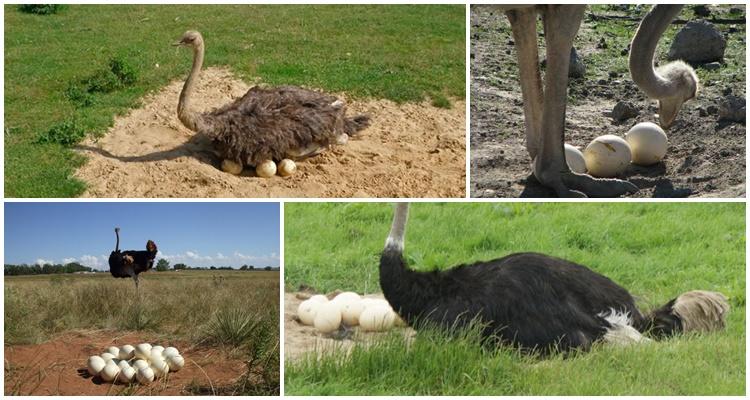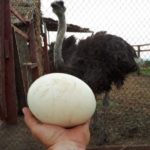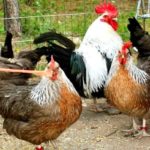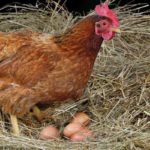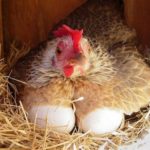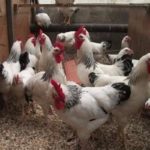Ostriches, like any birds, lay eggs. They are just as tasty and healthy as chicken ones, only much larger. By raising ostriches on home farms, you can make good money by selling eggs. Let's consider how many eggs an ostrich lays per year, per month and per day, how often females lay eggs. What factors influence egg production, how females hatch eggs at home.
How do farms make money?
Each egg weighs 1.5 kg for African breeds, 0.7-0.9 kg for emus.They can be sold in large quantities for food, or they can be sold individually to tourists during farm tours. Selling fertilized material for incubation will cost more.
How many eggs does an ostrich lay?
The overall egg production of a female ostrich depends on the breed. On average, it is 50 per year, with a maximum of 80 pieces. African ostriches carry this much, Australian ostriches carry 11-20 for each female, and the rhea is considered the leader in this indicator.
The egg production period for birds raised on home farms occurs in the spring. Females lay 1 egg per day, followed by a break. Thus, you can get from 15 pieces per month from an ostrich.
How often do ostriches lay eggs?
Sexual maturity in female ostriches occurs at 2 years. They do not lay eggs all year round, like chickens, but only during the short breeding season. If males also live with females, then the eggs will be suitable for incubation. If they are not fertilized, then they can only be used for food.
What affects egg production?
The number of eggs received from females can be affected by housing conditions, climatic conditions and food quality. The state of the body and the functioning of the reproductive system are affected by temperature, humidity and lighting. If ostriches are hot or cold, they will rush, but not as intensely as at a comfortable temperature of 15-20˚C.
The humidity in the room where the birds are kept should not be high, because in their homeland ostriches live in arid areas. A humidity of 60% is quite enough for the birds to live comfortably and have stable egg production. The length of daylight should be at least 8 hours. To do this, during short days, you need to turn on the lamps in the mornings and evenings for a while.
If conditions are violated, females begin to lay fewer eggs than would be expected from them. Severe stress that females experience when moving to another room, transportation, or the appearance of a new individual in the flock can reduce egg production or temporarily stop it. However, the effects of stress do not last long, and the females begin to lay eggs again.
Affects the amount of material laid and nutrition. The functioning of its body depends on what the bird eats. With good, balanced nutrition, females lay eggs as expected. But if the body is deficient in nutrients, this will affect the formation of eggs. During the breeding season, ostriches must not only be fed plenty, but also be fed with vitamin preparations, premixes or simply herbs, vegetables, fruits, herbal flour in winter, chalk and salt.
How does a bird hatch eggs?
Under natural conditions, ostrich families consist of 1 male and 1-3 females, one of them is the main one. She is the first to lay an egg in a common nest and incubates the clutch. All females rush in turn to the same place. Laying lasts 2 months. By the end there may be dozens of eggs in the nest.
The female sits on them, covers them with her body, and spreads her wings. Stays in the nest all day during the day, even in the midday heat, and does not get up to eat. Only predators can drive away the female. She feigns injury and runs away to lead the animals away from the nest. In some cases this helps and the nest remains intact.
Incubation lasts 6-7 weeks.It takes 2 days to emerge from the egg; the ostrich chicks themselves peck at the shell and get rid of it; adult birds do not help them with this. The hatched chicks spend the first 2 days sitting under their parents’ wings. They do not eat; the yolk remains in their stomachs, which serves as food for them.
On the 3rd day, the birds leave the nest, adult ostriches eat the remains of the shell to throw predators off the scent. And at the same time they replenish their body with calcium and vitamins. The male raises the chicks; he teaches the babies to run, find food, and escape from danger.
In nature, the hatchability of ostrich chicks is low - about 10-40%, since many eggs are carried away by predators. When breeding on a farm, this result is higher (up to 90%). Under artificial conditions, ostriches are bred in an incubator, although the females have not lost their instinct and can hatch on their own. To obtain material, families are formed from males and females (1 male for 3-4 females). Eggs are taken from a common nest, leaving 1-2 eggs in it every day so that the birds continue laying.
Incubation time is 6 weeks. Conditions: temperature – 36-36.5 ˚С, humidity – 25-35%, in recent days – 70%. The ostrich chicks are taken from the incubator as soon as they dry out and the fluff fluffs up. They are fed on the 3rd day. First, they give light food - a mixture of boiled eggs, cottage cheese and herbs. After 3 weeks of life, they are accustomed to mixed feed or grain mixtures with grass, vegetables, and root vegetables.
Up to 3-4 months, ostrich chicks are kept separately from their parents and other birds. The room where they live should be warm and light. Only a year after hatching, the ostrich chicks will reach more than half their adult size and weight.
How many eggs an ostrich can lay depends on its specific species. African breeds carry the largest ones. They are usually bred on farms to produce egg and meat products at the same time.With proper organization of economic activities, an ostrich farm can generate good income and become a local attraction.




